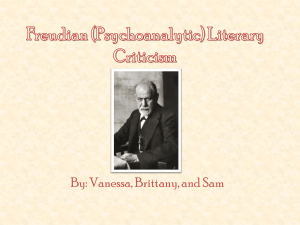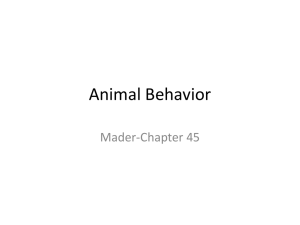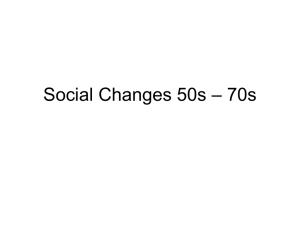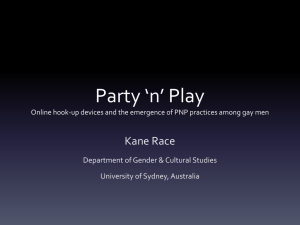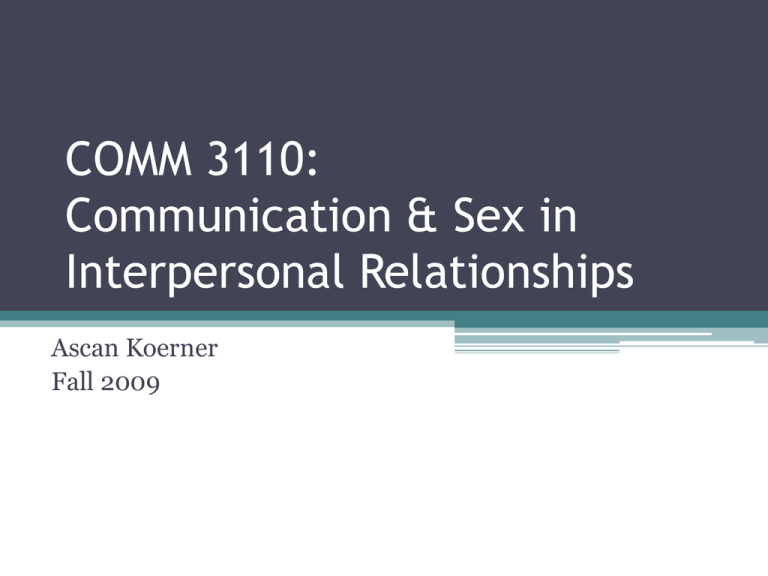
COMM 3110:
Communication & Sex in
Interpersonal Relationships
Ascan Koerner
Fall 2009
Two Academic Traditions
• Humanism
▫
▫
▫
▫
Multiple Realities
Free Will
Emancipation
Rules for
Interpretation
▫ Qualitative
Research
• Social Science
▫
▫
▫
▫
▫
Objective Truth
Determinism
Objectivity
Covering Laws
Quantitative
Research
Comparing Scientific and Humanist
Standards
Humanism
Science
•
•
•
•
•
•
•
•
•
•
Understanding
Clarification of Values
Aesthetic Appeal
Community of Agreement
Reform of Society
Explanation
Prediction
Parsimony
Falsifiability
Utility
Qualitative
-more interpretive
Ethnography
Textual Analysis
Survey
Experiments
Quantitative
- more objective
Defining Interpersonal
Communication (IPC)
Interpersonal Communication is any interaction
between two or more persons who exchange
information, create meaning, and influence each
other and who through this process create social
reality for themselves and others and create and
maintain relationships with each other.
Functions of IPC
•
•
•
•
•
Exchange information
Create meaning
Influence
Create social reality
Create & maintain relationships
Interpersonal Communication Goals
1) Self-Relevant Goals
- defining self & creating social reality for it
- meeting intra-personal needs (i.e., Maslow)
2) Relational Goals
-relationship development, maintenance, &
termination
- meeting inter-personal needs (e.g,. Schutz)
3) Instrumental Goals
- exchange and distribute resources
Associations between Goals
• Independent
▫ Achieving one goal unrelated to achieving other
goals
• Compatible
▫ Achieving one goal aids in achieving other goals
• Incompatible
▫ Achieving one goal blocks achieving other goals
Issues complicating Communication
• Persons pursuing multiple goals
▫ Goals might be incompatible
▫ It is unclear which goals are pursued
• Meaning of communication ambiguous!
▫ Meaning is subjective (i.e., multiple meanings)
▫ Meaning is negotiated between parties
▫ Meaning is context dependent
Social, cultural, situational…..
▫ Meaning operates at multiple levels
Content level: what message is ostensibly about
Relational level: what message says about partners
Cultural Beliefs about Sex
•
•
•
•
•
Morality
Health
Individual Growth
Relationship
Gender & Gender relations
Meaning of Sex
• Defines Identity for self and other
▫ Sexuality
▫ Social status / self-worth
▫ Ability to express passion, affection, caring
• Defines relationship
▫ Nature of affiliation
▫ Expectations for future interaction
Exercise: Discuss meaning for
self/other/relationship of:
•
•
•
•
•
Requesting sexual intimacy
Requesting partner use condom
Using condom yourself
Telling partner to stop a sexual behavior
Requesting oral or anal sex
Communicating about Sex difficult
because:
• Multiple Goals
• Multiple Meanings
• Large influence of context that is sex-negative
Hooking Up
• Sexual encounters, usually lasting only one
night, between persons who are strangers or
acquaintances, typically involving sexual
behavior which may or may not include sexual
intercourse.
From “calling” to “hookup”
• Different social scripts
▫ Calling: mother & daughter controlled access of
“gentleman caller”
▫ Dating (pre WW II): for social status, competition
for high ranking dates, low commitment
▫ Dating (post (WW II): going steady as preparation
for marriage
▫ Hooking up: sexuality without commitment
Factors contributing to hookup
culture
• Postponement of marriage (20/23 vs. 25/27)
• Large proportion of youth spends early
adulthood on campus
• Increased number of female students
• Focus on group activities
• Sexual revolution (24/51/72; 3/17/33)
• Feminism / Women’s rights
Theoretical Assumptions
• Culture directs (not reflects) human behavior
• Humans enact social roles
▫ E.g., man, woman, college student
• Actors follow scripts
▫ E.g., dating and hookup scripts
The social script
• A series of if-then contingencies whose meaning
exist in a shared social reality
▫ Shared understanding of social roles of actors
▫ Shared understanding of social situation
• As always, shared social reality is defined, and
may be redefined, thru communication
The hookup script
1.
2.
3.
4.
5.
Identifying hookup partner
Ascertain mutuality
Deciding on a location
Deciding on extend of sexual behavior
Continuing the relationship after hookup
1. Identifying a hookup partner
• Spontaneous attraction
• OR interest already established
• Factors contributing to attraction:
▫ Physical appearance
▫ Social attractiveness (status, behavior, network)
▫ Personality (extroversion, intelligences, etc.)
• Gender differences?
2. Ascertaining mutuality
• Following hookup script
• Nonverbal communication
▫ Eye-contact, facial expressions
▫ Attention paid
▫ Body posture (turn, lean, arms, etc.)
• Verbal communication
▫ Small talk
▫ Turn talking
3. Deciding on location
• Type of desired behavior and privacy of
current/potential space
• Pragmatic considerations
▫ Roommates, distance, safety
• Expectations of future interactions
4. Deciding on extend
of sexual behavior
• Personal norms & morals
• Perceived peer behavior/norms
• Expectation of future interaction
▫ If no future interaction:
Go farther
More sexual exploration
▫ If future interaction:
Don’t go as far
Less sexual exploration
5. Continuing the relationship
after hookup
• Hookup itself does not imply future relationship
▫ No change in relationship most likely outcome
▫ Hookup does not imply/create commitment
• Future relationship is possible, however
▫ Continue as friends/acquaintances
▫ Continue as non-committed, sexual relationship:
“repeat hookups, talking, hanging out”
▫ Develop into exclusive romantic relationships,
with committment
Hookup Scene I
• Psychological Factors favoring hookups
▫ Emerging adulthood
adult freedom w/o adult responsibilities
▫ Less interest in committed relationship
Marriage not until after college
College time of self discovery & experimentation
▫ Desire to fit in
Sensitivity to perceived norms
Freshmen most likely to participate in hookups
Hookup Scene II
• External Factors favoring hookups
▫
▫
▫
▫
Homogeneous population (class, age, race, etc.)
Familiarity with others (acquaintances & friends)
Physical proximity
(Perceived) Gender imbalance
Hookup Scene III
• Hooking up part of mainstream college culture
▫ The more central to college life one’s group, the
greater one’s participation
▫ Athletes & fraternity/sorority members
• Not participating:
▫
▫
▫
▫
Racial Minorities (foreign students?)
Gays / Lesbians
Religious students
Students in committed relationships
The role of alcohol
• Central part of student social scene, parties are
organized around it.
• Facilitates initiation of interaction (social
lubricant)
• Lowers inhibitions and thus facilitates sexual
behavior/experimentation
• Provides socially acceptable excuse for
“improper” behavior
Paper Assignment # 1
In a 3-5 page paper, please discuss aspects of the hook
up culture that Bogle describes that are consistent with
your experience at the U, as well as aspects that differ
from your experience, and offer an explanation for why
they are different. Try to focus on 2-3 aspects and make
your comparisons cogent. Aspects you may discuss
include, but are not limited to: who is hooking up,
outcomes, scripts, definitions, standards, etc. Make
coherent arguments and include specific references to
the text and class lecture material. Papers should be in
APA format, double-spaced, with 1 inch margins and 12
point font. Papers are due at the beginning of class,
October 6th.
Campus as sexual arena
• Information about peer culture (rules & norms)
▫ Thru mass media, popular culture
▫ Thru observation of college life
• Perceived Culture is used:
▫ as guide for own behavior
▫ to predict behavior of others
▫ to judge self and others
Self-serving biases
Fundamental attribution error
Third person effect
Common perceptions
• Gender differences in sexual activity
▫ Men have more sex with more partners
▫ Women have less sex with fewer partners
• Gender differences in sexual motivation
▫ Men desire sex more
▫ Women desire relationships more
▫ Ergo: women are more selective re. hookup
partner
▫ Ergo: women are more emotionally involved
Common Misperceptions
• Virginity is rare
▫ actually, 25-39 % of students are virgins
• Everyone participates in hookup culture
▫ although 80% of students had at least one hookup,
only 1/3 involve sexual intercourse
• Number of hookup partners is large
▫ UA study, of sexually active students, 90% had 2
or fewer partners, only 2% had more than 5
• Result: Pluralistic Ignorance
The big math problem
• US data (heterosexuals)
▫ Men during lifetime have 7 sex partners
▫ Women during lifetime have 4 sex partners
• UK data (heterosexuals)
▫ Men 12.7
▫ Women 6.5
• Obviously, this is not possible
▫ Survey data cannot be valid, but
▫ Survey data reflects persistent beliefs
Sexual Double Standard I
• “Good Girl” vs. “Bad Girl” perception of women
▫ aka “Madonna-whore complex” in which sexuality
is perceived to incompatible with love
• Divergent Interests
▫ Women increasingly interested in commitment
▫ Men maintain low interest in commitment
• College becomes “battle of sexes”
Sexual Double Standard II
• No (few?) rules regulating male sexuality
▫ promiscuousness valued
• Many rules restrict female sexuality
▫
▫
▫
▫
promiscuousness
Sexually provocative dress and/or behavior
Sexual relations with men who know one another
?? “houserats”
• Violations are sanctioned
▫ Bad reputation (e.g., “slut”)
▫ Stigmatization and ostracization
Sexual Double Standard III
• Strategies to deal with SDS
▫ Repeat hookup
▫ Friends with benefits
▫ Booty call
• All put sex in context of ongoing relationships,
which is a ore permissible expression of female
sexuality
Sexual Double Standard IV
• Manifestations of male power
▫ Perpetuation of hookup system even though it
does not meet women’s needs
▫ Men determine level of relationship involvement
& commitment
• This analysis is based on:
▫ Assumption of male power (patriarchy)
Group Assignment
• Does the sexual double standard work in men’s
best interest?
• What are men’s motivation (i.e., is it in their
interest to be in non-committed relationships so
that they can pursue other hookup partners)?
• Why are women perpetuating the SDS?
• What are alternative explanations of the SDS?
Life after College
• “Return” to Dating
▫
▫
▫
▫
Man initiates & pays for dinner/movie
Dyad focused activity at public place
Male chivalry
Sexual behavior delayed (until “right time”)
• However
▫ Sexual intercourse eventually normative
▫ Groups & alcohol still center of social life, not
dating
Reasons for demise of hookups
• Less homogeneous population (strangers)
• Logistics
▫ Driving increases riskiness and lowers alcohol use
▫ Greater distance between homes
• Adult responsibilities
▫ Limits amount of partying
▫ Lack of sleep & need to get up early
▫ Focus on social relations that aid careers
• Focus on finding long term partner
Double Standard remains
• Women still judged on sexual behavior
• Sexual behavior disqualifies women as long term
partner
• Consequently, both men and women become
more conservative sexually
Conclusion
• Hookup Culture result of
▫
▫
▫
▫
▫
▫
Campus environment
Changing social norms regarding sexual behavior
Decoupling of sex and love
Group & alcohol centered social life
Delayed Adulthood
Male dominance
Criticism of Bogle
• Oversimplification of Gender
▫ Sexual interest
▫ Relationship interest
• Reification of Pluralistic Ignorance
▫ Reliance on informants
▫ Uncritical stance toward informants
Gender Differences
• Limited to relatively few behaviors
• Variance within larger than variance between
♂ ♀
The other side of Hookup Culture
• Male Losers
▫ Less socially skillful
▫ Low status
▫ Men interested in relationships
• Sexual Enjoyment
• Relationship Intimacy
Jessica Valenti – feministing.com
• Purity Myth: morals are linked purely to sexual
behavior, rather than values like honesty, kindness,
and altruism
• In 2007, nearly 1,000 news and magazine articles
referred to the "girls gone wild" or "raunch culture"
phenomenon
▫ message: the only kind of sex young women can have
is dangerous, drunk sex that leaves them disheveled
and traumatized
• Fear is coercion to return to traditional gender
roles
Discussion Questions
• What was the point of Valenti’s message? Do you
agree/disagree with it? Why/why not?
• Shaida says, “’women who dance on tables, take a man home
on their own terms and carry themselves – at a bar and in the
classroom – with a sense of self-worth have my respect.’” Is it
possible for a woman to take a man home on her own terms
and carrying herself with a sense of self-respect possible? Cite
and apply reasons for why women and men engage in the
hook-up culture (according to Bogle and based on your own
interpretation).
• “Young women could see their way out of the hookup habit if
given the space and support to do so” (p. 170). If women are
not benefitting from a hook-up culture, why don’t they revolt
and get out of it?
The Vagina Monologues
• In 1996, Ensler interviewed over 200 women about their
experiences with sex, relationships, and violence against
women
▫ put their stories into the production The Vagina
Monologues.
• Monologues include references to women’s issues like
menstruation, feminine products, rape camps, traumatic
sexual experiences in childhood, prostitutes who make
women happy, and birth
• 2009: over 4,200 V-Day events around the world
Eve Ensler
Creator of The Vagina
Monologues
Discussion Questions
• Do productions like The Vagina Monologues
empower women to be more open about
sexuality? Why/why not?
• Do women talk about feminism and issues about
sexuality differently with men than with women?
If so, in what ways?
Islam: A brief Primer
• Monotheism
▫ Same God as Jews and Christians
• Muhammad is last (authoritative) prophet
• Afterlife
▫ Conduct on earth determines eternal life
▫ Free will and reason test belief
▫ Adherence to Islamic law (sharia) essential
Islam: How to behave
• All behavior falls into 1 of 7 category
1.
2.
3.
4.
5.
6.
7.
•
Obligatory (wajib)
Recommended (mustahab)
Allowed (halal)
Unimportant (mubah)
Disapproved but lawful (makruh)
Dubious (mushbooh)
Forbidden (haram)
A balanced life is essential
Islam and sexual behavior
• Sexuality important part of human existence
• Sexuality must be conducted according to sharia
• Sex only permissible in marriage or other
sanctioned relationship
• All other sex prohibited, including adultery,
homosexuality, prostitution, masturbation,
bestiality, etc.
• Applies to both sexes
Muslims in Thailand
• Ethnic & religious minority (5-6%) from
southern provinces usually speaking Malay
• Easily identified through language & dress
• Sexually more restricted than rather open Thai
culture, esp. in regard to transexuality
• Muslim migrants congregate in specific
neighborhood in Bangkok, the study site
Thai Muslims vs. US college students
• Important similarities?
• Important Differences?
• In light of above, what sexual behaviors would
you predict?
Social Identity Theory
• Identity is significantly determined by group
membership
• Persons consistently compare their groups to
other groups
• Persons seek positive distinctiveness of own
group
• Persons adhere to group norms and publicly
exhibit signs of group membership
• Identification range:
▫ internalization – conformity – rejection
Sexual Culture of Young Thais
• Two basic groups
▫ Religious & studious (sexually conservative)
▫ Heart breakers (sexually permissive)
• Heterosexual relationships
▫ Kik (primarily friends, some sexual behaviors)
▫ Dating (some sexual behavior, not necessarily
intercourse)
▫ Pre-marital relationships (including intercourse)
▫ Temporary marriage (intercourse implied)
Gender Differences
• Males
▫
▫
▫
▫
Strong sexual urges assumed
Masturbation frequent means to manage urges
Initiation in brothels common
Fast used to control urges
• Females
▫ Sexual urges assumed to be weak
▫ Virginity and modesty valued
▫ Romance and emotion involved in relationship
Sexual Beliefs and Health
• Sex normal expression of male health
• Sex normal expression of female love
• Contraception (esp. condoms) morally suspect
▫
▫
▫
▫
Not used in romantic relationships
High risk for STD/STI
High risk of pregnancy
High rate of abortions
The Theory of Evolution
Life evolves through the dual process of random
mutation and selection, such that those changes
that increase a gene’s (i.e., usually its carrier)
reproductive success are passed on to future
generations and spread through the gene pool,
whereas changes that decrease a gene’s (i.e.,
usually its carrier) reproductive success are not
passed on and disappear from the gene pool.
Theory of Evolution (Darwin)
• Variation (random change of traits)
• Inheritance (passing on of traits to offspring)
• Selection (of advantageous traits)
- Survival (of the fittest)
- Reproduction (sexual selection)
Inclusive Fitness (Hamilton)
• Evolution understood from the gene’s
perspective(I.e., Selfish Gene)
▫ Essentially, genes evolve
▫ Solves “problem” of altruism and similar unfit
behaviors of organisms
Evolved Psychological
Mechanisms
• Assumption: Brain is modular with highly
specialized circuitry
• EPMs solve specific recurring problems of
survival or reproduction
• EPMs take in limited information
• EPMs use decision rules to obtain output
• output can be psychological, physiological, or
behavioral
Environment of Evolutionary
Adaptedness (EEA)
• Those factors that determine fitness and
selection of an adaptation
• Factors might be environmental OR social
• Many of the social factors might not be
temporally stable
Human Ancestors’ EEA
•
•
•
•
Small groups (families?) of hunter gatherers
Hierarchically organized
Warfare among groups
Trading among groups
Recurring Problems
• Manage in-group (familial) relationships
▫ coalitions, loyalty, trust, affection
• Manage power relationships
▫ Power sources, coercion, influence, obedience
• Conduct warfare
▫ Aggression, bravery, peacemaking
• Conduct trade
▫ Valuations, bargaining, trust
Sexually intimate relationships
• Most significant adult relationship for most
people (90% +)
• Conflict, including discord & dissolution, are
normal
• Love and emotions are central
▫ Affection, lust, joy, etc.
▫ Anger, hurt, jealousy, etc.
Sexual Selection
• Intra-sex competition
▫ Members of the same sex compete over access to
mates of opposite sex
▫ Individual “fitness” determines success
• Inter-sex selection
▫ Members of opposite sex choose and get chosen
mate from opposite sex
▫ Displaying preferred characteristics determine
success
▫ This process can also be adversarial, however
Sexual Strategies
• Evolved Psychological Mechanisms for mating
• Employed outside of awareness
• Are probabilistic
Recurring Problems
•
•
•
•
Mate Selection
Attracting Mate
Keeping Mate
Replacing Mate
Culture and Context
• EPMs and C&C interact
• C&C provide input for EPMs
• C&C constrain behavioral options
Barriers to Understanding
•
•
•
•
•
•
•
Perception: evolution too long a time frame
Ideology: past abuse of evolutionary theory
Naturalistic fallacy: existence implies morality
Antinaturalistic fallacy: “harmony with nature”
Misconception of biological determinism
Feminism: ET implies gender inequality
Idealism: romantic view of love
Sexual reproduction in humans
• Long pregnancy and childhood require long
term commitment of both parents
• Hidden ovulation
▫ Uncertain paternity
▫ Makes controlling access to female reproductive
resources difficult
• Conditions favorable for long term committed
relationships
Sex differences in reproduction =
differences in sexual strategies
• Men = unlimited reproductive resources:
▫ Many gametes (~ 6 trillion in lifetime)
▫ Long reproductive life (60+ years)
▫ Low risks and costs of intercourse
• Women= limited reproductive resources:
▫ Few gametes (~ 400 in lifetime)
▫ Shorter reproductive life (~30 years)
▫ Pregnancy (and intercourse) risky (high mortality)
and costly (gestation & lactation, mating
opportunities)
Mate preferences
• Attributes one finds desirable (attractive) in a
mate
• Preferences are based on EPMs for attributes
that facilitate reproductive success
• Because many attributes (and EPMs) contribute
to reproductive success, outcomes of EPMs need
to be integrated (i.e., weighted)
• Integration by additional EPM or build into
EPMs for individual attributes
Women’s Preferences
• Resources
▫
▫
▫
▫
▫
▫
▫
▫
▫
Economic Capacity
Social Status
Age
Ambition & Industriousness
Dependability & Stability
Intelligence
Compatibility
Size, Strength & Health
Love & Commitment
Alternative Explanation
• Structural Powerlessness of women
▫ Women universally desire men with resources
because they are universally less powerful
• Evidence Against
▫ In societies with economically powerful women,
similar mate preferences remain
▫ In U.S., high earning women desire even higher
earning men
Paper Assignment # 2
In a 3-5 page paper, please describe a situation in which
you experienced conflict with a partner in a romantic
relationship that can be explained by Evolutionary
Theory. Specifically, show how the conflict is the result
of each partner pursuing a mating strategy that is
incompatible with the partner’s goals.
Make coherent arguments and include specific
references to the text and class lecture material. Papers
should be in APA format, double-spaced, with 1 inch
margins and 12 point font. Papers are due at the
beginning of class, November 10th.
Men’s mate preferences
• Reproductive challenges
▫ Select fertile mate
▫ Assure paternity
• EPM to solve these problems
Determining fertility
• Attraction to physical features associated with
fertility
▫ Youthfulness in appearance & behavior
▫ Symmetry: disease and parasite free
▫ Body shape: waist to hip ratio <0.70
Evidence for mate preferences
• Preferences for facial features already present in
infants
• Physical appearance much more important for
men than women
• High mate value men select young & beautiful
mates
• Mate preferences of homosexuals mirror those
of heterosexuals
Determining paternity
• Chastity
▫ Female virginity important to men
• Fidelity
▫ Faithfulness most attractive to men
▫ Unfaithfulness most unattractive to men
▫ Promiscuity is very unattractive also
Game theory
• Achieving individuals’ goals requires
cooperation
• In cooperative setting, individuals that cheat
(obtain greater rewards with less costs than
others) will gain advantage
▫ Individuals develop cheating strategies
▫ Individuals develop strategies for discovery and
punishment of cheaters
▫ Systems reach some state of equilibrium
Group discussion
• Identify situations in which men & women
“cheat” on their long term mates
• What strategies exist for cheating?
• What strategies exists for cheating detection and
sanctioning?
Casual Sex
• Sex outside committed relationship
• Relatively large size of male testes testament to
sperm competition, that is, females that mate
with more than one partner
• Rates of insemination also indicative of sperm
competition
Questions
• Are there sex differences regarding casual sex
observable today?
• What are the most important ones?
• How can we explain them?
Sex differences re. casual sex
• Men more motivated to engage in casual sex
(higher sex drive)
• Evidence:
▫ Sexual behavior of homosexual
▫ Prostitution
▫ Cultural institutions of polygamy
• Consequence:
▫ Access to casual sex becomes important resource
that women control
Men & causal sex
• Significant reproductive advantages
▫ Casual sex can dramatically increase # of offspring
▫ If cuckoldry, can also increase resources available
to offspring
• Costs
▫ Need to expend resources to attract sex partners
▫ Loss of primary partner
▫ Threat of injury/death from sex partner’s
associates
▫ STDs
Men’s EPM for casual sex
• Lust
▫ Desire for sex per se (visual sexual fantasies)
▫ Desire for multiple, novel partners (Coolidge
effect)
▫ Perceptions of attractiveness
▫ Different (i.e., lower) standards for sex partners
compared to mates
Women & causal sex
• Reproductive advantages
▫ Casual sex can increase quality of male genes
▫ Casual sex allows to women to trade sex for other
material and social resources
• Significant Costs
▫
▫
▫
▫
Loss of primary partner & resources for offspring
Loss of ability to attract long term mate
Threat of injury/death from sex partner
STDs
Women’s EPM for casual sex
• Lust
▫ Desire for sex partner with higher mate value
▫ Timing of affairs to coincide with estrus
▫ Quality of orgasm in casual sex
• However, generally lower sex drive than men
Attracting a mate
• Mate preference alone insufficient for pairing
with desirable mate (unless socially powerful)
• Attracting mate requires possession & display of
attributes mates find attractive
• Deception and deception detection become
relevant
• Intra-sex competition also relevant
▫ Competition
▫ Degradation
Challenges for men
• Attracting long term mate= possess & display
▫
▫
▫
▫
Resources / resource potential
status
partner commitment / understanding
willingness to spent resources on partner & child
• Attracting short term sex partner = display
▫ Resources & willingness to spend on partner
▫ Status / self-confidence & bravado
▫ Physical strength & handsomeness
Challenges for women
• Attracting long term mate= possess & display
▫ Fecundity (health & youth)
▫ partner commitment / faithfulness
▫ willingness to parent
• Attracting short term sex partner = display
▫ Sexual availability
▫ Physical beauty
Male deception as mating strategy
• Conditions
▫ Men pursue both long and short term partners
▫ For short term, deception viable option:
About resources & status
About interest in long term relationships
Female strategies
• For long term partner
▫ Extent courtship period to detect deception
▫ Play “hard to get” to discourage short term sex
partners
▫ “Convert” sex-partner to long term partner
• For short term partner
▫ Signal availability, e.g., submissiveness
▫ Sexualize appearance
Intra-sex competition
• Verbal degradation unique to humans
▫ Degrade desirable attributes of competition
▫ For men: resources and/or ability to commit
resources, status, involvement with others, etc.
▫ For Women: sexual fidelity, beauty & desirability,
etc.
• Strategies might backfire
• Strategies that degrade both short and long term
mate value particularly effective
Keeping a mate
• Childrearing requires long term commitment
from both parents
• Long-term cooperation between parents also has
other benefits, e.g., division of labor,
complementary skills, mutual support, etc.
• Costs of long term commitment are primarily
opportunity costs, i.e., the benefits an alternate
mate could provide
Five Strategies
•
•
•
•
•
Pair-bond, adult attachment
Supply mate with desired resources
Keep competitors at bay
Emotional manipulation
Increase costs of defection for partner
Infant Attachment
The Strong Bond between Infant & Primary Care
Giver
• Innate (shared with many other animals)
• Necessary for Survival & Development
• Attachment system interacts with parenting to
produce attachment styles
Parent’s Behavior and Infant’s
Attachment Style
• Reliably Available
Secure Attachment
• Reliably Unavailable
Avoidant Attachment
• Unreliably Available/Over Involved
Anxious/Ambivalent Attachment
However, parenting behavior is also determined
by child behavior
Adult Attachment (LOVE)
• Assumption that attachment system also applies
to adult romantic relationships
• Similar physiological/cognitive foundation
• For women, attachment consequence of sexual
intercourse
Display of Attractive Traits
• Continuous display of attractive traits keeps
mate interested in relationship
• For both sexes, display of love & commitment
most important
• Similar sex differences as in initially attracting
mate
Keep competition at bay
•
•
•
•
•
Vigilance
Public displays of commitment
Monopolizing mate
Concealing mate (exclusively male strategy)
Display jealousy
Emotional manipulation
• Using guilt/shame
• Submission/self-abasement
• Provoke jealousy
Jealousy
• EPM in response to perceived threat to
relationship
• Motivates mate keeping behaviors
• Increases cost of defection for partner
• Increases cost of mate snatching for others
EPM and behavior
• Any complex behavior affected by multiple
EPMs and/or other, more mindful cognitive
processes
• EPMs can trigger other EPMs
▫ Jealousy Anger/Rage
• Resist simplistic explanations!
Sexual Conflict
• Conflict occurs whenever one person interferes
with the goal achievement of another
• Sexual conflict occurs when one person
interferes with the reproductive goals of another
• Often, the interference is mutual. That is, by
pursuing their own reproductive goals, one sex
interferes with the goals of the other sex
Responses to conflict
• Emotional: aversive psychological state
▫ Anger
▫ Hurt
▫ Jealousy
• Cognitive:
▫ Problem solving
▫ Planning influence strategies
• Behavioral:
▫ Responsive to other’s goals
▫ Responsive to own goal
Common Sexual Conflicts
• Sexual Access
• Men pursue access to multiple females
▫ Avoid commitment of all resources to one female
▫ Perceive women as overly sexually interested
▫ Sexual aggression
• Women restrict access to few men
▫ Withholding sex generally, make it more valuable
▫ Withhold sex to test commitment
▫ Use sexuality to manipulate men
Common Sexual Conflicts
• Emotional Expressions
▫ Emotional commitment as sign of willingness to
invest resources
▫ Moodiness as cost, forces compliance
▫ Moodiness tests commitment
▫ Moodiness requires attention
Deception as conflict strategy
• Works if it reduces perceived incompatibility of
goals
• Men:
▫ Deceive about resources
▫ Deceive about commitment
• Women:
▫ Deceive about sexual availability
▫ Deceive about fertility (youth & health)
Relational Violence / Abuse
• Relational Violence / Abuse almost always
attempts to control (sexual) behavior of other!
▫ Often result from lack of other means (resources,
status, interpersonal skills, etc.)
• Perpetrated equally by both sexes, but male to
female violence more physically intense
Assignment
• Do all or any of the three cases represent rape?
▫ Why? Why not?
• Does knowledge of EPMs involved in rape make
any difference in your judgment?
• What behavioral strategies would you
recommend to avoid being in such situations?
▫ For men & for women
Rape
• No evidence that rape evolved as independent
mating strategy
• More likely manifestation of sexual aggression
• Also enacted in pursuit of non-sexual goals
• Associated with:
▫
▫
▫
▫
Misogyny
Acceptance of “rape myth”
Hostility, impulsiveness, hypermasculinity
promiscuity
Terminating Relationships
• Permanent Commitment disadvantageous
▫
▫
▫
▫
Survival of partner not certain
Partner might decrease in mate value
Self might increase in mate value
Superior alternatives might become available
• EPM to monitor partner and alternatives and to
terminate if advantageous
• EPM might NOT be different from EPM that
motivates maintenance!!!
Divorce frequent/(normative?)
• Majority of sexual/romantic relationships
dissolve in U.S. and cross-culturally
• Some evidence for serial monogamy, however
• Reasons are associated with reproductive values
▫
▫
▫
▫
▫
Infidelity: #1 reason for divorce
Infertility: # 2 reasons for divorce
Lack of economic support: reason for women
Sexual withdrawal
Cruelty & unkindness
Social Exchange Theory
• Evaluation of rewards & costs associated with
resources in a given relationship
• Rewards: things perceived to be beneficial, often
because of their value to survival/reproduction
• Costs: things perceived to be detrimental, often
because of their value to survival/reproduction
Five Aspects of Exchange
1) Rewards & Costs: Difference vs. Ratio?
2) Absolute Rewards and Costs
3) Immediate Rewards and Costs
4) Forecast Rewards and Costs
5) Cumulative Rewards and Costs
Profit vs. Equity Motivation
Profit = an individual’s rewards/cost ratio
Equity = each person’s rewards/costs ratio is
about equal
Example: 10/5 compared to 100/95
Profit: 5 vs. 5 = similar profitable
Equity : 2 vs. 1.05 = unequitable
Social Exchange Theory
(Thibaut & Kelly)
• Terms
O = Perceived Outcome
CL = Expectation
CLalt = Perceived Alternatives
• Predictions about Relationship
Satisfaction: compare O and CL
Stability: compare O and CLalt
Relationship Outcomes predicted
by Social Exchange Theory
O > CL
satisfied
unstable
O < CL
dissatisfied
unstable
O > CLalt
satisfied
stable
dissatisfied
stable
Stability
Satisfaction
O < CLalt
Termination of fatherhood
• Movement to allow non-biological fathers to
cease fatherhood in case of divorce
• Current law: married partner presumed to be
father, regardless of biological relatedness
• Does genetic unrelatedness creates
moral/ethical basis for termination of
fatherhood?
Changes over Time
• Contextual Changes lead to differences behavior
▫ Due to changes in input
▫ Due to alternative EPMs
• Significant changes
▫
▫
▫
▫
Changes in mate value of self, partner, alternatives
Loss of desire
Menopause
Changes in males to females ratio
Mate values
• Women:
▫ Reproductive potential spikes early, then
continuously declines until menopause
▫ Nurturing, parenting skills & ability to provide
resources increase steadily
• Men:
▫ ability to provide resources and status increase,
peak relatively late, then decline
Consequences of changing MVs
• Lowered commitment, especially for men
• Decreases in male guarding of females,
experiences of sexual jealousy
• No changes in female guarding of male,
vigilance, monopolisation
Loss of desire
• Experienced by both sexes, although male more
sensitive to loss of youth and beauty of female
• Lowered commitment, especially for males
• Directing more effort/resources to children
Menopause
• Steady decline of female fertility until infertility at
ages 40-50.
• Associated with decrease in sexual desire/activity
• Shifting of effort/resources to
children/grandchildren
• Increase of extramarital affairs toward end of
reproductive period for women
Changes in sex ratio
• In early life of women, more men available than
women, but ratio changes with age 1.08 to 0.40
• Mating very competitive for young men, who are
aggressive, take high risks, & have higher
mortality
• Later in life, men are more likely to change
partners
Lifelong Commitment
• Despite changes, many/most couples stay
together for life
• Suggests that love as EPM is most powerful
reproductive mechanism
Harmony between sexes
• Men and females are overwhelmingly similar
psychologically, including EPMs related to pair
bonding, parenting, cooperation, forming and
maintaining social relationships.
• Life long commitment, experienced as love and
desire to fulfill partner’s needs & desires,
primary mating strategy
• Some differences due to different reproductive
challenges
▫ Mate preferences & mating strategies
Conflict between sexes I
• Inter-sex conflict due to co-evolution of male &
female mating preferences/strategies
• Female preference of resourceful mates
▫ male attempts to monopolize resources (ambition,
dominance, aggression)
▫ Male coalitions to obtain resources (hunting/war)
and to protect
• Obscure ovulation & uncertain paternity
▫ male attempts to control access to female
reproduction
Conflict between sexes II
• Inter-sex conflict due to conflicting interests
▫ Because the reproductive capacity of females is so
much lower than that of men, unfaithfulness in
men can always increase the number of their
offspring – conflicts with women’s interest in long
term commitment by male
▫ Because high value men are in relatively short
supply, unfaithfulness in women can almost
always increase the quality of genes of offspring –
conflicts with male interest in certain paternity
Evolution and feminism
• Both observe similar phenomena, but conclusion
are different. Who is right?
Conflict within sexes
• Similarities of strategies employed by same sex
others leads to appearance of solidarity
• Most conflict, however, is intra-sex
• Limited number of high value mates leads to
competition
▫ As long as potential mates differ in the qualities
desired by other sex, competition is inevitable
• Conflict is the natural state!
Mating and Morality
• Advantageous for both men and women to
convince others of morality of lifelong
commitment
▫ Leads competitors to limit their sexual behaviors
▫ Increases partner’s commitment (esp. for women)
▫ Increases chances of paternity (for men)
• “Evolutionary accounts that emphasize the
sexually indiscriminate male and the sexually
coy female overstate the case” (p.215)
Other examples of EPMs underlying
morality
•
•
•
•
Incest avoidance
Virginity
Female submissiveness
Male protection
Changes resulting from evolution
• Adaptation: Change that positively affects
reproductive success
• Exaptation: Adaptation originally developed for
one function that now serves different function
• By-product: Consequence of an adaptation that
in itself was not selected for
• Cooptation: inherited trait that is nonfunctional
• Vestigal Structure: remains of historical
adaptation that no longer have any function
Women’s hidden mating strategies
•
•
•
•
Female Orgasm
Women’s ability/proclivity to have affairs
Menstrual cycles and sexual behavior
Men’s ability to detect ovulation
Female Orgasm
• Adaptation?
• NO: not necessary for reproduction
• YES:
▫
▫
▫
▫
Hedonic hypothesis
Mr. Right hypothesis
Paternity confidence hypothesis
Sperm retention hypothesis
• Empirical evidence supports combination of
hypotheses in support of adaptation
Women’s Affairs
• Adaptation?
• NO: too costly with little benefit
• YES:
▫ Good genes hypothesis
▫ Mate switching hypothesis
Menstrual cycle’s influence on sex
• Greater sexual desire at height of fertility, but
only for men other than primary partner
• Greater sexual attraction to more masculine men
at height of fertility (face)
• Greater attraction to more symmetrical men at
height of fertility (smell)
Men’s detection of ovulation
• Men’s behavior toward women sensitive to
ovulation
• Women emit subtle visual and olfactory cues to
ovulation
• Men’s ability to detect them is uncertain
• Men’s behavior could also be due to behavioral
changes in women
Adaptations
• Traits are selected for that increase an
organism’s reproductive success relative to
intra-species and inter-species competitors
• Adaptations do NOT need to be optimal, just
better than competition
• Rarely, if ever, are adaptations perfect solutions
to recurring problem
• Also, human behavior is never determined by
adaptations alone
Mysteries of mating
•
•
•
•
•
•
Homosexuality
Cross-sex friendship
Friends as rivals & mate poachers
Rape & Rape defenses
Cognitive biases
Fetishism & sexualizations
Homosexuality
• If homosexuality leads to exclusive homosexual
relationships, clearly should be selected against
• Theories that suggest some benefits for relatives
of homosexuals not supported!
• However, system of sexual attraction that
depends on “learning” often adaptive
• Also, sexual attraction possibly result of multiple
EPM, that can combine to effect homosexuality
• Also, neural connections can misalign
Friendship
• Yes, men & women can be friends
• Sexual desires might emerge, particularly from
men
• Same sex friends might poach mates
• Ultimately, reproduction more important than
coalitions, but only marginally so
• Social constraints usually regulate those
relationships, however
Rape & Rape defense
• Ultimately, evidence much stronger for rape as
by-product than rape as adaptation
• No real evidence for EPMs for rape defense,
again suggesting no EPMs for rape
Cognitive biases
• Error Management theory.
▫ Cognitive biases in favor of attributions that
increase reproductive success
▫ Cost/benefit of false positive vs. cost/benefit of
false negative
• Men: overestimate female availability
• Women: underestimate male commitment
• Both: overestimate infidelity
Fetishism & sexualization
• Most fetishes reduce reproductive potential, as
they usually erotisize behaviors not leading to
impregnation
• Fetishism suggest great plasticity of human
sexuality
• Sexualization and erotisation of non-sexual
behaviors also suggest sexual drive is malable!
Sex and evolution
• Behavior (incl. sexual) is complex, multifunctional,
& resists simple (evolutionary) explanations
• SB affected by numerous EPMs
• EPMs and environments interact
• EPMs affected by learning & early experiences
• SB affected by rules & norms
• SB affected by partner, inherently dyadic
• All behavioral instincts subject to override by
conscious will (higher cognitive functions)
• However, EPMs determine many cognitive
processes related to sexual behavior and cannot be
ignored



